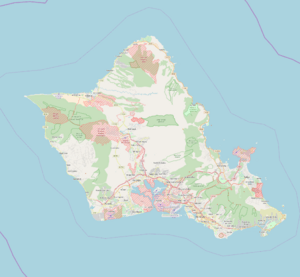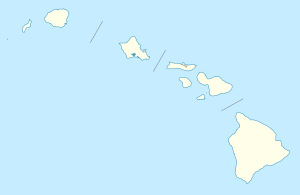Falls of Clyde (ship) facts for kids

Falls of Clyde at Honolulu in 2008
|
|
| History | |
|---|---|
| Name | Falls of Clyde |
| Namesake | Falls of Clyde, Lanarkshire |
| Port of registry |
|
| Builder | Russell & Co, Port Glasgow |
| Yard number | 17 |
| Launched | 12 December 1878 |
| Completed | 13 February 1879 |
| Identification | IMO number: 8640313 |
| Status | Museum ship |
| General characteristics | |
| Type | Iron-hulled sailing ship |
| Tonnage | 1,807 GRT, 1,741 NRT |
| Length | 266.1 ft (81.1 m) |
| Beam | 40.0 ft (12.2 m) |
| Depth | 23.5 ft (7.2 m) |
| Sail plan | 4-masted full-rig |
| Notes | Figurehead: a maiden |
|
Falls of Clyde (Four-masted oil tanker)
|
|
|
Formerly listed on the U.S. National Register of Historic Places
|
|
| Location | Pier 7, Honolulu Harbor, Hawaii |
| Built | 1878 |
| Architect | William Lithgow |
| NRHP reference No. | 73000659 |
| Significant dates | |
| Added to NRHP | 2 July 1973 |
| Designated NHL | 11 April 1989 |
| Removed from NRHP | 2 February 2024 |
| Delisted NHL | 13 December 2024 |
The Falls of Clyde is a very special ship. It's the last of its kind: an iron-hulled, four-masted full-rigged ship. It's also the only remaining sailing ship that was designed to carry oil. In 1989, it was named a U.S. National Historic Landmark, which means it was recognized as a very important historical site. However, because of its poor condition, it was removed from this list in 2024. Today, officials in Hawaii are looking for ways to deal with the ship, possibly by taking it apart. You can't visit the ship right now.
Contents
The Ship's Early Life and Voyages
The Falls of Clyde was built in Port Glasgow, Scotland, by a company called Russell and Company. It was launched on December 12, 1878. This ship was the first of nine similar iron-hulled, four-masted ships. It was named after the Falls of Clyde, which are beautiful waterfalls on the River Clyde in Scotland.
The ship was built to the highest standards for trading all over the world. Its first trip took it to Karachi in British India. For its first six years, it mostly sailed in the India trade, carrying goods between countries. After that, it became a "tramp" ship, meaning it didn't have a regular route. It carried all sorts of cargo, like wood, jute, cement, and wheat, from places like Australia, California, India, New Zealand, and the British Isles.
Becoming an American Ship
After 21 years as a British merchant ship, the Falls of Clyde was bought by Captain William Matson in 1899 for $25,000. Captain Matson owned the Matson Navigation Company. He took the ship to Honolulu, Hawaii, and it was registered under the Hawaiian flag. When Hawaii became part of the United States in 1900, a special law was needed from the U.S. Congress to allow this foreign-built ship to sail as an American vessel.
To save money on crew members, Captain Matson changed the ship's rigging. He turned it into a barque, which meant replacing some of its sails with easier-to-manage ones. At the same time, he added a deckhouse and other rooms to carry paying passengers. From 1899 to 1907, the ship made over 60 trips between Hilo, Hawaii, and San Francisco, California. It carried goods to Hawaii and sugar back to California, along with passengers. It was known for being fast and comfortable, usually completing its trips in about 17 days.
Life as an Oil Tanker
In 1907, the Associated Oil Company bought the Falls of Clyde. They changed it into a bulk oil tanker, which means it could carry large amounts of oil. They built ten big steel tanks inside its hull. They also added a pump room, boiler, and generator. In this new role, the ship carried kerosene to Hawaii and brought molasses (used for cattle feed) back to California.
In 1927, the ship was sold again to the General Petroleum Company. Its masts were cut down, and it became a floating fuel station in Alaska.
Saved from the Scrapyard
In 1959, a man named William Mitchell bought the ship and towed it to Seattle, Washington. He hoped to sell it to a group that would preserve it. However, his plan didn't work out. Other efforts by people like Karl Kortum and Fred Klebingat to find a home for the ship in California also failed.
In 1963, the bank that owned the Falls of Clyde decided to sell it to be sunk. The plan was to use it as part of a breakwater (a barrier to protect a harbor) in Vancouver, Canada. But Kortum and Klebingat managed to get people in Hawaii interested in saving the ship. Within days of its scheduled sinking, they raised enough money to buy it. In late October 1963, the Falls of Clyde was towed to Honolulu, safe from being sunk.
The Ship as a Museum
The Falls of Clyde was given to the Bishop Museum in Hawaii and opened to the public as a museum ship in 1968. In 1970, a shipbuilder named Sir William Lithgow, whose grandfather helped design the original ship, offered to help restore it. His shipyard in Scotland donated new steel masts and other parts made of Oregon pine wood.
In 1973, the ship was added to the National Register of Historic Places. Later, in 1989, it was named a U.S. National Historic Landmark, recognizing its great historical importance.
Challenges and Efforts to Save the Ship
By 2008, the ship was in very poor condition. It hadn't been dry-docked (taken out of the water for repairs) in a long time, and important maintenance hadn't been done. There were also concerns about how money raised for the ship's care was being used.
In 2008, the Bishop Museum announced plans to sink the ship unless private money was raised to care for it forever. In September 2008, the museum agreed to give ownership to a non-profit group called Friends of Falls of Clyde. This group hoped to restore the ship. Many items from the ship had already been removed or disappeared because people thought it would be sunk. The Friends group received $350,000 from a foundation, but they couldn't get more money from federal programs. They hoped to get the ship into drydock each year but were not successful. In June 2016, the Hawaii Department of Transportation (HDOT) took away the ship's permit to stay at Pier 7, saying it was a safety risk.
Restoration and Repatriation Efforts
In August 2016, a group from Glasgow, Scotland, started the Save Falls of Clyde – International (FOCI) Campaign. Their goal was to bring the ship back to Scotland. They worked with the Friends of the Falls of Clyde group and tried to create a plan with HDOT.
In February 2019, HDOT tried to auction off the ship, but no one made a qualified bid. In July 2021, HDOT asked for bids to remove the ship from Honolulu Harbor. Two proposals were received. The Friends group argued that they still owned the ship and challenged HDOT's assessment.
In November 2021, HDOT accepted a bid from FOCI to transport the ship to Scotland, where it would be restored. However, in May 2022, HDOT canceled the bid, stating that FOCI did not meet the contract's conditions.
Since then, the state has started looking for bids to scrap the ship. The ship was removed from the Hawaii Register of Historic Places. It was also removed from the National Register of Historic Places on February 1, 2024, and its National Historic Landmark status was taken away in December 2024.







